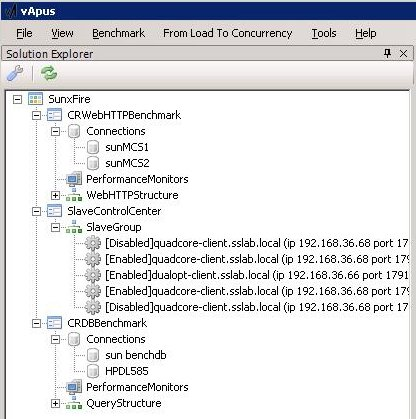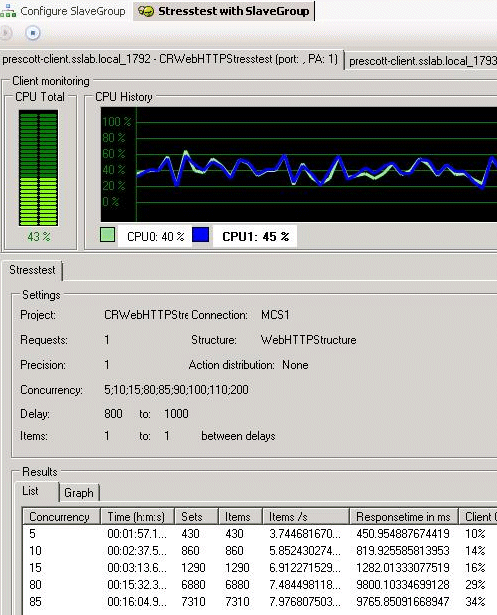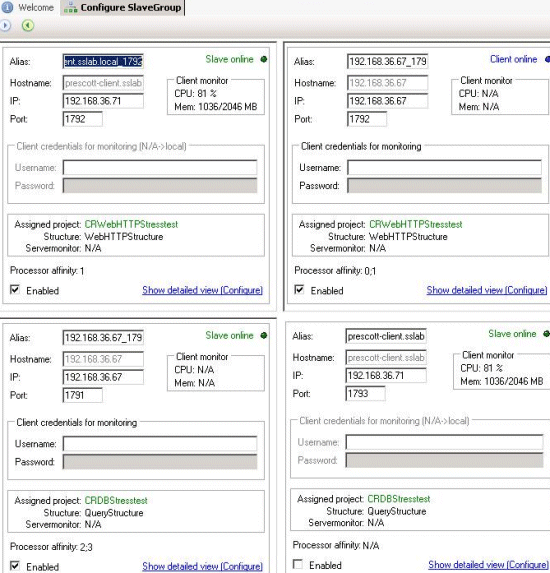Real-world virtualization benchmarking: the best server CPUs compared
by Johan De Gelas on May 21, 2009 3:00 AM EST- Posted in
- IT Computing
vApus: Virtual Stress Testing
Testing uses real-world databases and websites. To make this as realistic as possible we use vApus. vApus or Virtual Application Unique Stresstest is a stress test developed by Dieter Vandroemme, lead developer of the Sizing Server Lab at the University College of West-Flanders. The basic setup works as follows. Each application is logged during business use in the peak hours. These logs are analyzed by the vApus application and queries/URLs requested are grouped into user actions. vApus will simulate the actual actions that people have done by performing these actions again on the application running on a server in our lab. A well-tuned threading mechanism developed in-house launches one thread per user.
The cool thing is that vApus allows us to perform several completely different stress tests on several servers simultaneously. This is ideal for virtual server testing. Let's discuss this a bit more.

Above you can see the connection to -- in this case -- the Sun XFire 4450 server (which is no longer in our lab). Several performance monitors can be started on each tested server. The CRWebHTTPBenchmark is the first benchmark that will be performed, in our case on virtual servers 2 and 3. The CR means "Continuous Rate": each user will perform an action every second (this is configurable of course). The CRDBBenchmark (the third item under the "SunxFire" connection) is the Continuous Rate benchmark for the Decision Support Database.

Above you see what the results look like, in this case on one of our slowest servers. Concurrency indicates how many users are hitting the website, and Item/s is the throughput. We constantly monitor the client CPU to make sure that the client machine is never the bottleneck.
The vApus "master" process launches several separate processes called "slaves", which will stress test a separate server or VM. In our case, there are three slaves: two web tests and one database test will all run in parallel. As vApus must be cheap to use, we wanted to avoid situations where you need a massive battery of clients. Besides the fact that every Slave has an extremely tuned threading system to simulate users, each Slave can have affinity set to one or more CPU(s) of the client PC it runs on. For this test, we used two client machines: a quad-core Core 2 Quad Q6600 at 2.4GHz and our old dual Opteron 2.6GHz test system.

As you can see above, we carefully monitor CPU usage so that we are sure that our clients are never the bottleneck. The beauty of this system is that we were able to simulate between…
- 600-800 Database users on VM1
- Two times 80-110 web users on VM2 and VM3
…while running only two clients. Our quad-core client should have been sufficient, but we wanted to play it safe and give each slave at least two CPUs. The two clients and one master are directly connected via a gigabit switch to the test servers.










66 Comments
View All Comments
binaryguru - Monday, June 1, 2009 - link
It seems to me, x86-based virutalization software is getting more and more complicated. Not only is x86 virtualization getting more complicated, it is getting more and more difficult to get reliable performance from it.Let me explain my point.
The industry is clearly trying to do more with less hardware these days. Getting raw VM performance on commodity hardware is getting to a point where there is no predictable way to plan for an efficient VM environment.
Current VM technology is trying to simulate the flexibility and performance of mainframes. To me, this is clearly an impossible goal to achieve with the current or future x86 platform model.
All of the problems the industry is experiencing with VM consolidation does not exist on the mainframe. Running 4 'large' VMs for 'raw' performance. How about running 40 'large' VMs for 'raw' performance. Clearly, we all know that is impossible to achieve with current VM setups.
Now I'm not saying that virtuallization is a bad idea, it clearly is the ONLY solution for the future of computing. However, I think that the industry is going about it the wrong way. Server farms are becoming increasingly more difficult to manage, never mind the challenge of getting 100s of blade servers to play nice with each other while providing good processing throughput.
This problem has been solved about 20 years ago; and yet, here we are, struggling again with the "how can I get MORE from my technology investment" scenario.
In conclusion, I think we need to go back to utilizing huge monolithic computing designs; not computing clusters.
mikidutzaa2 - Friday, May 29, 2009 - link
Hello,It would be useful (if possible) to have latency numbers/response times on the tests as well because rarely we are interested in throughput on our servers. What we usually care more is how long it takes the server to respond to user actions.
What is your opinion?
JohanAnandtech - Friday, May 29, 2009 - link
I agree. I admit it is easier for us or any benchmark person to use throughput as immediately comparable (X is 10% faster than Y) and you have only one datapoint. That is why almostResponsetime however can only be understood by drawing curves relative to the current throughtput / User concurrency. So yes, we are taking this excellent suggestion into consideration. The trade off might that articles get harder to read :-).
mikidutzaa2 - Friday, May 29, 2009 - link
Looking forward to your new articles then, glad to hear :).The articles don't necessarily have to be harder to read, you could put the detailed graphs on a separate page and maybe show only one response time for a "decent"/medium user concurrency.
Also, I would find interesting (if you have time) to have the same benchmarks with 2vcpu machines, I think this is a more common setup for virtualization. Very few people I think virtualize their most critical/highly used platforms - at least that's how we do it. We need virtualization for lightly used platforms (i.e. not very many users) but we are still very much interested in response time because the users perceive latency, not throughput.
So the important question is: if you have a virtual server (as opposed to a physical one) will the users notice? If so, by how much is it slower?
Thank you.
RobAm - Tuesday, May 26, 2009 - link
It's good to see some unbiased analysis with respect to virtualization. It's also especially interesting that your workloads (which look much more like real world apps my company runs as opposed to SPECjbb, vmark, vconsolidate) shows a much more competitive landscape than vmware and Intel portray. Also, doesn't vmware prohibit benchmarking without their permission. Did they give you permission? Has VMware called offering to re-educate you? :-)Brovane - Tuesday, May 26, 2009 - link
I was hoping for a some benchmarks on the Xeon x7xxx CPU for the Quad Socket Intel boxes. We are currently have Dell R900's and we where looking at adding to our ESX cluster. We where debating between the R900 with Hex cores our Xeon x55xx series CPU's in the R710. I see the x55xx series where bench marked but nothing on the Xeon MP series unless I am missing that part of the article.JohanAnandtech - Tuesday, May 26, 2009 - link
Expect a 24-core CPU comparison soon :-).Brovane - Tuesday, May 26, 2009 - link
You also might want to a 12-core comparison also. We have found that with a 4-socket box that you usually run out of memory before you run out CPU power. With the R900 having 32-Dimm Sockets, the R900's we purchased last year have 64GB of RAM and just use 2x2.93Ghz CPU's we max memory before CPU easily in our environment. Since Vmware licensing and Data Center licensing is done per Socket we only populate 2 of the sockets with CPU's and this seems to do great for us. You basically double your licensing costs if you go with all 4 sockets occupied. Just a thought as to how sometimes virtualization is done in the real world. There is such a price premium for 8GB memory Dimm's it isn't worth it to put 256GB in one box with all 4 sockets occupied. The 4GB Dimm's did reach price parity this year so we were looking at going for 128GB of memory on our new R900's however Intel also released Hex-core so we still don't see much reason to occupy all 4 sockets.yasbane - Tuesday, May 26, 2009 - link
I know positive feedback is always appreciated for the hard work put in but it seems very rare that we see any non-microsoft benchmarks for server stuff these days on Anandtech. Is there any particular reason for this...? I don't mean to carp but I recall the days when non-microsoft technologies actually got a mention on Anandtech. Sadly, we don't seem to see that anymore :(Cheers
JohanAnandtech - Tuesday, May 26, 2009 - link
Yasbane, my first server testing articles (DB2, MySQL) were all pure Linux benches. However, we have moved on to a new kind of realworld benchmarks and it takes a while to master the new benchmarks we have introduced. Running Calling Circle and Dell DVD store posed more problems on Linux than on Windows: we have lower performance, a few weird error messages and so on. In our lab, about 50% of the servers are running linux (and odd machines is running OS-X and another Solaris :-) and we definitely would love to see some serious linux benchmarking again. But it will take time.Xen benchmarks are happening as I write this BTW.